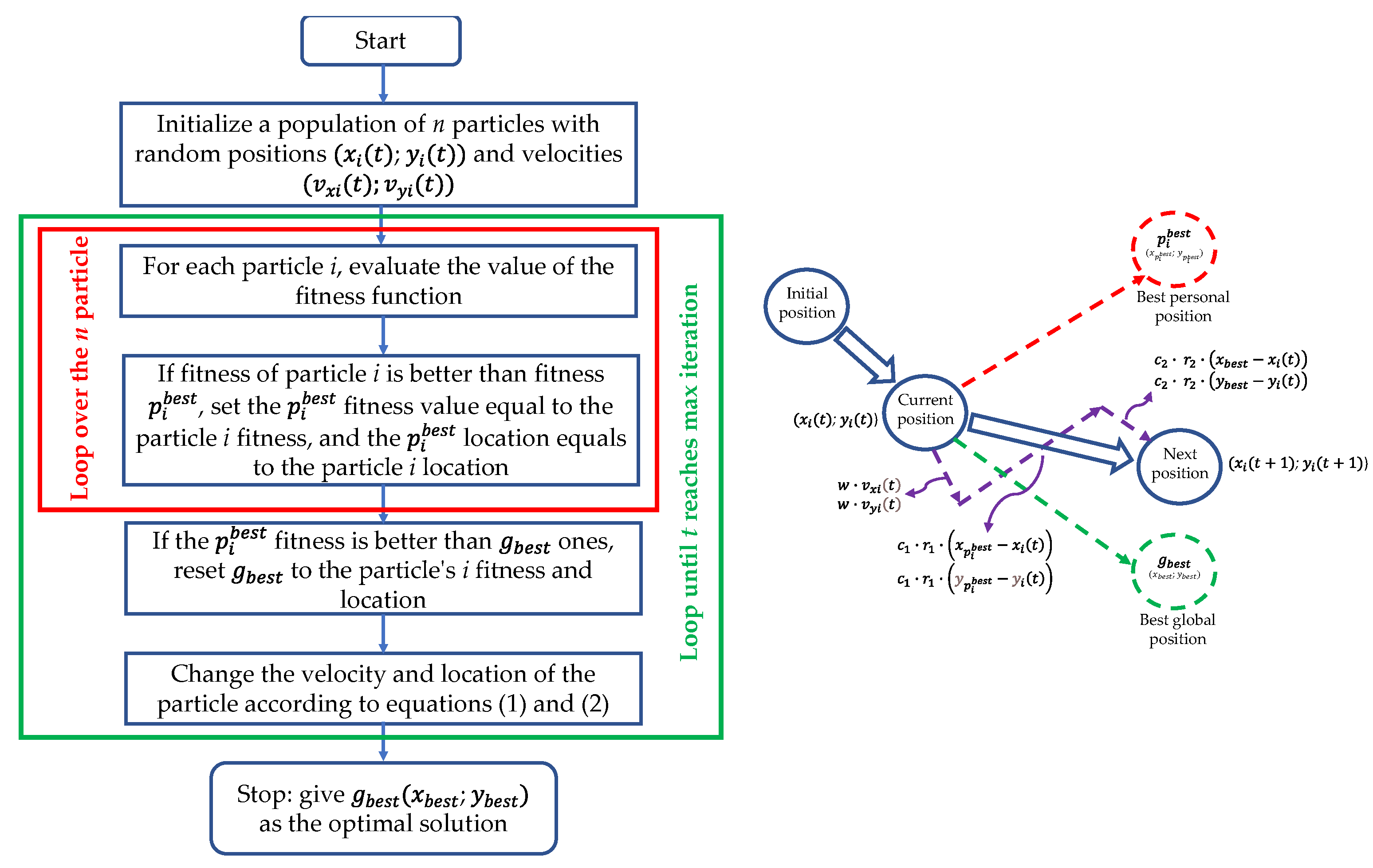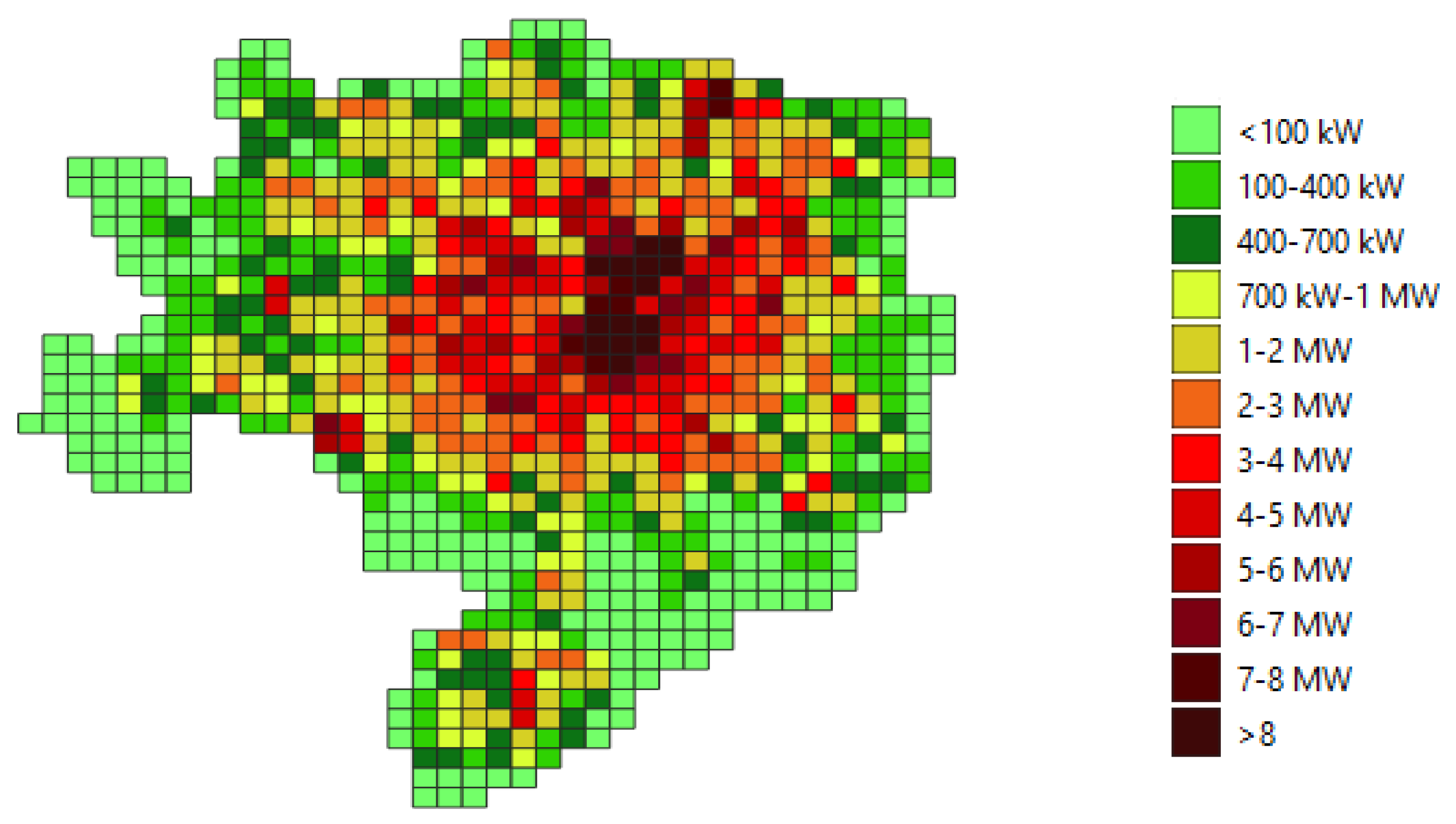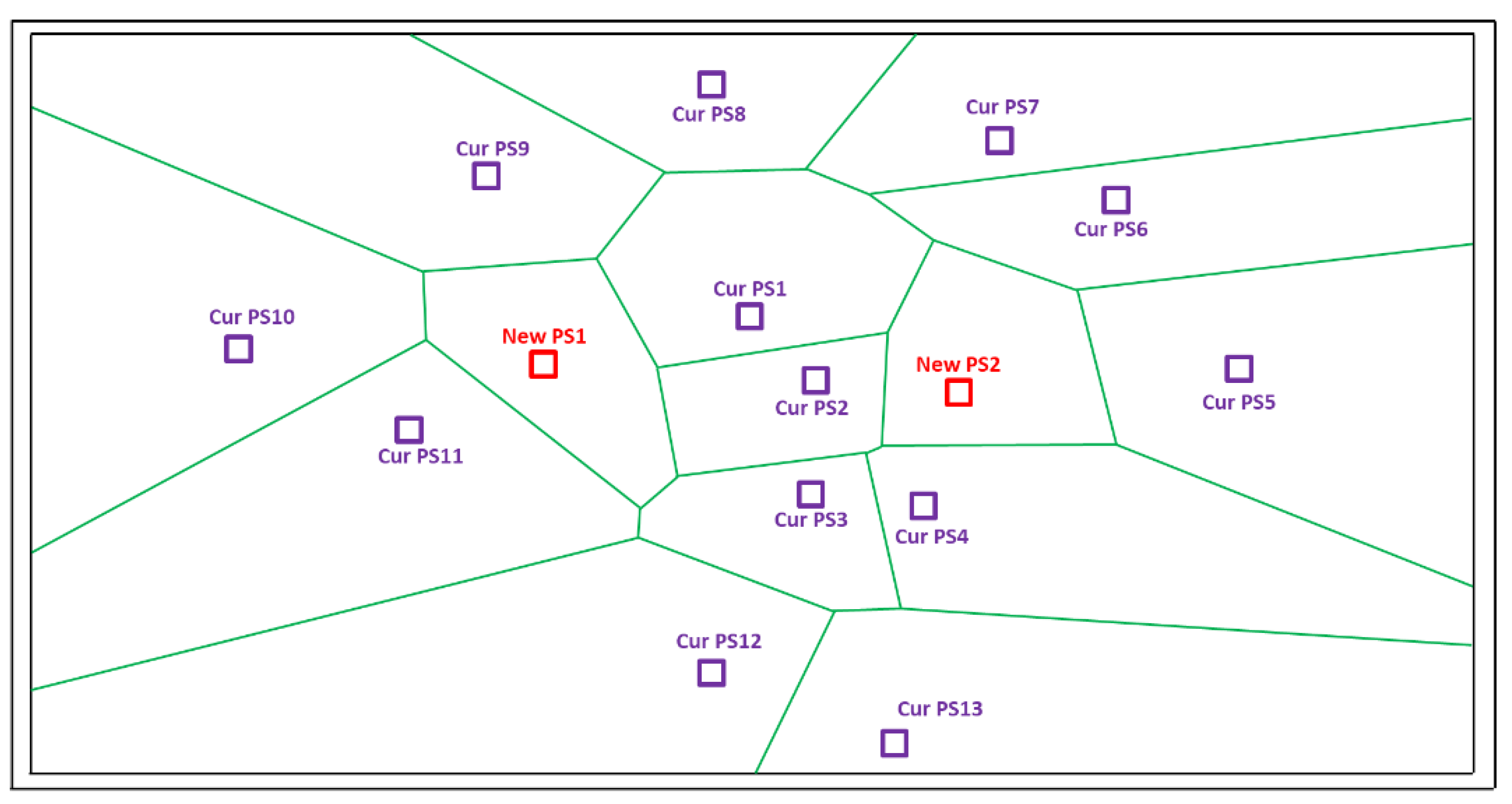A GIS-Based Approach for Primary Substations Siting and Timing Based on Voronoi Diagram and Particle Swarm Optimization Method
Abstract
:Featured Application
Abstract
1. Introduction
2. PSs Siting and Timing: Technical Background and Problem Formulation
- A GIS for capturing, elaborating, and displaying spatial input data.
- A PSO algorithm to optimally locate the new PSs.
- A Voronoi diagram-based approach assesses the PSO solutions quality and finds the PS service areas.
2.1. Geographic Information System (GIS)
2.2. Particle Swarm Optimization (PSO)
- 1.
- Initialize a population of n particles with random positions ; and velocities , where t denotes the considered iteration. It is worth noticing that the positions and velocities can be defined based on the dimensions of the problem space;
- 2.
- For each particle i, evaluate the value of the fitness function;
- 3.
- Compare particle’s fitness with particle’s i personal best ;. If the particle’s i fitness value is better than fitness, then set the fitness value equal to the particle’s i fitness, and the location equals the particle’s i location;
- 4.
- Compare the fitness of with the population’s overall previous fitness ;. If the value is better than ones, reset to the particle’s i fitness and location;
- 5.
- Change the velocity and location of the particle according to Equations (1) and (2), respectively:where and are random numbers between 0 and 1, which weight the velocity for the acceleration toward and locations; constants and are parameters of the PSO algorithm; is the position that gives the best fitness value ever explored by particle i and is the one explored by all the particles in the swarm. The parameter is the inertia weight, a constant value between 0 and 1, and determines how much the particle should keep on with its previous velocity, i.e., the speed and direction of the search. The parameters and are called the cognitive and the social coefficients, respectively. They control how much weight should be given between refining the particle’s search result and recognizing the swarm’s search result. These parameters can be considered as the trade-off between exploration and exploitation. It is worth noticing that, and ; are two-position vectors, and their difference is a vector subtraction. Adding this subtraction to the original velocity is to bring the particle back to the position ; similarly, for the difference and ;.
- 6.
- Loop to step 2 until a criterion is met, usually meeting the target value of the fitness function or the maximum number of iterations.
2.3. Perpendicular Bisector Rule and the Voronoi Diagram
- Voronoi edges: where the closest neighbor of a point changes. Every point on a Voronoi edge is equidistant from at least two sites.
- Voronoi cells: all points closer to a given site than any other site.
- Voronoi vertex: the intersection of at least three edges. It is equidistant from at least three sites.
3. Proposed GIS-Based Approach
3.1. GIS-Based Input Data Preparation
3.1.1. Power System Data
3.1.2. Green Areas and Disused or Abandoned Buildings
3.1.3. Population Data and PSs Dimension
- Outdoor PS: allowed only in low-density areas; needs an available area greater than 6200 m2 (corresponding to 2.5% of the size of each square).
- Indoor PS: mandatory in medium and high-density areas; requires at least 2500 m2 of available area (corresponding to 1% of the size of each square).
3.2. PSs Optimal Siting
3.2.1. Multi-Site PSO Algorithm for PSs Location
3.2.2. Weighted Voronoi Diagram Approach for PSs Location
3.2.3. Overview of the PSs Siting Optimization Approach
3.3. PSs Optimal Timing
4. Simulation Results
4.1. Siting and Timing of Three New PSs
4.2. Siting and Timing of Eighth PSs
4.3. Siting and Timing of Eleven PSs
4.4. Comprehensive Analysis of the Simulations
5. Conclusions and Future Works
Author Contributions
Funding
Institutional Review Board Statement
Informed Consent Statement
Data Availability Statement
Acknowledgments
Conflicts of Interest
References
- Bosisio, A.; Amaldi, E.; Berizzi, A.; Bovo, C.; Fratti, S. A MILP approach to plan an electric urban distribution network with an H-shaped layout. In Proceedings of the 2015 IEEE Eindhoven PowerTech, Eindhoven, The Netherlands, 29 June–2 July 2015. [Google Scholar] [CrossRef]
- Vigano, G.; Clerici, D.; Michelangeli, C.; Moneta, D.; Bosisio, A.; Morotti, A.; Greco, B.; Caterina, P. Energy transition through PVs, EVs, and HPs: A case study to assess the impact on the Brescia distribution network. In Proceedings of the 2021 AEIT International Annual Conference (AEIT), Milan, Italy, 4–8 October 2021; pp. 1–6. [Google Scholar] [CrossRef]
- Picioroaga, I.; Eremia, M.; Ilea, V.; Bovo, C. Resilient operation of distributed resources and electrical networks in a smart city context. UPB Sci. Bull. Ser. C Electr. Eng. Comput. Sci. 2020, 82, 267–278. [Google Scholar]
- Iannarelli, G.; Bosisio, A.; Greco, B.; Moscatiello, C.; Boccaletti, C. Flexible resources dispatching to assist DR management in urban distribution network scenarios including PV generation: An Italian case study. In Proceedings of the 2020 IEEE International Conference on Environment and Electrical Engineering and 2020 IEEE Industrial and Commercial Power Systems Europe, EEEIC/I and CPS Europe 2020, Madrid, Spain, 9–12 June 2020. [Google Scholar]
- Bosisio, A.; Moncecchi, M.; Morotti, A.; Merlo, M. Machine Learning and GIS Approach for Electrical Load Assessment to Increase Distribution Networks Resilience. Energies 2021, 14, 4133. [Google Scholar] [CrossRef]
- Tanwar, S.S.; Khatod, D. A review on distribution network expansion planning. In Proceedings of the 2015 Annual IEEE India Conference (INDICON), New Delhi, India, 17–20 December 2015. [Google Scholar] [CrossRef]
- Sekhar, A.N.; Rajan, K.S.; Jain, A. Spatial informatics and Geographical Information Systems: Tools to transform Electric Power and Energy Systems. In Proceedings of the TENCON 2008-2008 IEEE Region 10 Conference, Hyderabad, India, 19–21 November 2008. [Google Scholar] [CrossRef]
- Camargo, V.; Lavorato, M.; Romero, R. Specialized genetic algorithm to solve the electrical distribution system expansion planning. In Proceedings of the 2013 IEEE Power & Energy Society General Meeting, Vancouver, BC, Canada, 21–25 July 2013. [Google Scholar] [CrossRef]
- Aghaei, J.; Muttaqi, K.; Azizivahed, A.; Gitizadeh, M. Distribution expansion planning considering reliability and security of energy using modified PSO (Particle Swarm Optimization) algorithm. Energy 2014, 65, 398–411. [Google Scholar] [CrossRef] [Green Version]
- Koutsoukis, N.C.; Georgilakis, P.S.; Hatziargyriou, N.D. A Tabu search method for distribution network planning considering distributed generation and uncertainties. In Proceedings of the 2014 International Conference on Probabilistic Methods Applied to Power Systems (PMAPS), Durham, UK, 7–10 July 2014; pp. 1–6. [Google Scholar] [CrossRef]
- Baharuddin, I.N.Z.; Roslan, R.; Omar, R.C.; Zulkarnain, M.S.; Wahab, W.A.; Solemon, B. Enhancement of application model for substation site selection. Int. J. Eng. Adv. Technol. 2019, 9, 3626–3630. [Google Scholar] [CrossRef]
- Phayomhom, A.; Rugthaicharoencheep, N.; Chaitusaney, S. GIS application to distribution substation planning in MEA’s power system. In Proceedings of the 2015 12th International Conference on Electrical Engineering/Electronics, Computer, Telecommunications and Information Technology (ECTI-CON), Hua Hin, Thailand, 24–27 June 2015. [Google Scholar] [CrossRef]
- Ghusti, P.; Sarno, R.; Ginardi, R.H. Substation placement optimization method using Delaunay Triangulation Algorithm and Voronoi Diagram in East Java case study. In Proceedings of the 2016 International Conference on Information & Communication Technology and Systems (ICTS), Surabaya, Indonesia, 12 October 2016; pp. 208–213. [Google Scholar] [CrossRef]
- Wang, S.; Lu, Z.; Ge, S.; Wang, C. An Improved Substation Locating and Sizing Method Based on the Weighted Voronoi Diagram and the Transportation Model. J. Appl. Math. 2014, 2014, 1–9. [Google Scholar] [CrossRef]
- Vahedi, S.; Banejad, M.; Assili, M. Optimal location, sizing and allocation of subtransmission substations using K-means algorithm. In Proceedings of the 2015 IEEE Power & Energy Society General Meeting, Denver, CO, USA, 26–30 July 2015. [Google Scholar] [CrossRef]
- Mazhari, S.M.; Monsef, H.; Romero, R. A Hybrid Heuristic and Evolutionary Algorithm for Distribution Substation Planning. IEEE Syst. J. 2013, 9, 1396–1408. [Google Scholar] [CrossRef] [Green Version]
- Vahedi, S.; Banejad, M.; Assili, M. GIS-Based Substation Expansion Planning. IEEE Syst. J. 2020, 15, 959–970. [Google Scholar] [CrossRef]
- Yu, L.; Shi, D.; Guo, X.; Xu, G.; Jiang, Z.; Jian, G.; Lei, J.; Jing, C. GIS-based optimal siting and sizing of substation using semi-supervised learning. In Proceedings of the 2017 IEEE Green Energy and Smart Systems Conference (IGESSC), Long Beach, CA, USA, 6–7 November 2017; pp. 1–6. [Google Scholar] [CrossRef]
- Jiao, R.; Yang, Z.; Shi, R.; Lin, B. A multistage multiobjective substation siting and sizing model based on operator-repair genetic algorithm. IEEJ Trans. Electr. Electron. Eng. 2014, 9, S28–S36. [Google Scholar] [CrossRef]
- Adamiak, M.; Jażdżewska, I.; Nalej, M. Analysis of Built-Up Areas of Small Polish Cities with the Use of Deep Learning and Geographically Weighted Regression. Geosciences 2021, 11, 223. [Google Scholar] [CrossRef]
- Pantiga-Facal, E.; Plasencia-Lozano, P. A GIS-Based Analysis of the Light Rail Transit Systems in Spain. Appl. Sci. 2022, 12, 1282. [Google Scholar] [CrossRef]
- Puangkaew, N.; Ongsomwang, S. Remote Sensing and Geospatial Models to Simulate Land Use and Land Cover and Estimate Water Supply and Demand for Water Balancing in Phuket Island, Thailand. Appl. Sci. 2021, 11, 10553. [Google Scholar] [CrossRef]
- Kennedy, J.; Eberhart, R. Particle swarm optimization. In Proceedings of the ICNN’95-International Conference on Neural Networks, Perth, WA, Australia, 27 November–01 December 1995; Volume 4, pp. 1942–1948. [Google Scholar]
- Pokojski, W.; Pokojska, P. Voronoi diagrams–inventor, method, applications. Pol. Cartogr. Rev. 2018, 50, 141–150. [Google Scholar] [CrossRef] [Green Version]
- Bosisio, A.; Berizzi, A.; Amaldi, E.; Bovo, C.; Morotti, A.; Greco, B.; Iannarelli, G. A GIS-based approach for high-level distribution networks expansion planning in normal and contingency operation considering reliability. Electr. Power Syst. Res. 2020, 190, 106684. [Google Scholar] [CrossRef]
- Aurenhammer, F.; Edelsbrunner, H. An optimal algorithm for constructing the weighted voronoi diagram in the plane. Pattern Recognit. 1984, 17, 251–257. [Google Scholar] [CrossRef]
- Wang, C.A.; Tsin, Y.H. Finding constrained and weighted Voronoi diagrams in the plane. Comput. Geom. 1998, 10, 89–104. [Google Scholar] [CrossRef] [Green Version]
- QGIS. QGIS Website. Available online: https://qgis.org/it/site/ (accessed on 17 July 2021).
- UNARETI, Piano di Sviluppo e Incremento Resilienza. 2021. Available online: https://www.unareti.it/unr/unareti/elettricita/cittadini/piano-di-sviluppo-e-incremento-resilienza/ (accessed on 27 January 2022).
- Home-Geoportale Della Lombardia. Available online: https://www.geoportale.regione.lombardia.it/ (accessed on 25 January 2022).
- Geoportale SIT|Comune di Milano. Available online: https://geoportale.comune.milano.it/sit/ (accessed on 27 January 2022).
- Portale Open Data|Comune di Milano. Available online: https://dati.comune.milano.it/ (accessed on 27 January 2022).






























| Particles i | … | … | ||||||||
|---|---|---|---|---|---|---|---|---|---|---|
| 1 | 1,511,310 | 5,030,533 | 1,504,760 | 5,033,038 | 1,512,544 | 5,033,515 | … | … | 1,505,567 | 5,038,227 |
| 2 | 1,509,044 | 5,033,231 | 1,519,752 | 5,038,845 |  | |||||
| … | … | … | … | … | ||||||
| n | 1,514,184 | 5,027,623 | 1,512,018 | 5,025,146 | ||||||
| Particles i | ||||||||||||
|---|---|---|---|---|---|---|---|---|---|---|---|---|
| 1 | 1,511,310 | 5,030,533 | 1,504,760 | 5,033,038 | ||||||||
| 2 | 1,509,044 | 5,033,231 | 1,519,752 | 5,038,845 | ||||||||
| … | … | … | … | … | … | … | … | … | … | … | … | … |
| n | 1,514,184 | 5,027,623 | 1,512,018 | 5,025,146 | ||||||||
| Best |  |  |  |  |  |  |  |  |
| 1° Iteration | 2° Iteration | 3° Iteration | 4° Iteration | |||||
|---|---|---|---|---|---|---|---|---|
| PS Name | Fitness [km] | PS Timing | Fitness [km] | PS Timing | Fitness [km] | PS Timing | Fitness [km] | PS Timing |
| PS1 | 1.60 | 2 | 1.58 | 3 | 1.50 | 3 | - | 3 |
| PS2 | 1.80 | 4 | 1.70 | 4 | 1.65 | 4 | 1.40 | 4 |
| PS3 | 1.75 | 3 | 1.56 | 2 | - | 2 | - | 2 |
| PS4 | 1.50 | 1 | - | 1 | - | 1 | - | 1 |
| PSs in Construction Order | X Coordinate | Y Coordinate | Best Average Distance [km] | Best Average Weighted Distance [km] | Best Average Weighted Distance Variation [km] |
|---|---|---|---|---|---|
| AS-IS | 1.82 | 1.48 |  | ||
| 1 | 1,513,006 | 5,026,223 | 2.11 | 1.35 | 1.54 |
| 2 | 1,513,960 | 5,039,246 | 1.44 | ||
| 3 | 1,512,544 | 5,033,505 | 1.35 | ||
| PSs in Construction Order | X Coordinate | Y Coordinate | Best Average Distance [km] | Best Average Weighted Distance [km] | Best Average Weighted Distance Variation [km] |
|---|---|---|---|---|---|
| AS-IS | 1.82 | 1.48 |  | ||
| 1 | 1,513,007 | 5,026,217 | 1.70 | 1.08 | 1.54 |
| 2 | 1,513,754 | 5,039,166 | 1.44 | ||
| 3 | 1,512,619 | 5,033,319 | 1.35 | ||
| 4 | 1,509,507 | 5,032,761 | 1.28 | ||
| 5 | 1,515,013 | 5,034,529 | 1.22 | ||
| 6 | 1,512,011 | 5,037,233 | 1.17 | ||
| 7 | 1,516,543 | 5,040,503 | 1.12 | ||
| 8 | 1,507,716 | 5,035,412 | 1.08 | ||
| PSs in Construction Order | X Coordinate | Y Coordinate | Best Average Distance [km] | Best Average Weighted Distance [km] | Best Average Weighted Distance Variation [km] |
|---|---|---|---|---|---|
| AS-IS | 1.82 | 1.48 |  | ||
| 1 | 1,513,010 | 5,026,222 | 1.73 | 0.98 | 1.54 |
| 2 | 1,513,752 | 5,039,173 | 1.44 | ||
| 3 | 1,511,950 | 5,032,438 | 1.36 | ||
| 4 | 1,508,634 | 5,033,486 | 1.29 | ||
| 5 | 1,515,044 | 5,034,710 | 1.23 | ||
| 6 | 1,512,006 | 5,037,262 | 1.18 | ||
| 7 | 1,517,698 | 5,037,654 | 1.13 | ||
| 8 | 1,516,543 | 5,040,503 | 1.08 | ||
| 9 | 1,512,300 | 5,034,664 | 1.05 | ||
| 10 | 1,517,821 | 5,034,554 | 1.01 | ||
| 11 | 1,513,852 | 5,033,367 | 0.98 | ||
Publisher’s Note: MDPI stays neutral with regard to jurisdictional claims in published maps and institutional affiliations. |
© 2022 by the authors. Licensee MDPI, Basel, Switzerland. This article is an open access article distributed under the terms and conditions of the Creative Commons Attribution (CC BY) license (https://creativecommons.org/licenses/by/4.0/).
Share and Cite
Bosisio, A.; Berizzi, A.; Merlo, M.; Morotti, A.; Iannarelli, G. A GIS-Based Approach for Primary Substations Siting and Timing Based on Voronoi Diagram and Particle Swarm Optimization Method. Appl. Sci. 2022, 12, 6008. https://doi.org/10.3390/app12126008
Bosisio A, Berizzi A, Merlo M, Morotti A, Iannarelli G. A GIS-Based Approach for Primary Substations Siting and Timing Based on Voronoi Diagram and Particle Swarm Optimization Method. Applied Sciences. 2022; 12(12):6008. https://doi.org/10.3390/app12126008
Chicago/Turabian StyleBosisio, Alessandro, Alberto Berizzi, Marco Merlo, Andrea Morotti, and Gaetano Iannarelli. 2022. "A GIS-Based Approach for Primary Substations Siting and Timing Based on Voronoi Diagram and Particle Swarm Optimization Method" Applied Sciences 12, no. 12: 6008. https://doi.org/10.3390/app12126008
APA StyleBosisio, A., Berizzi, A., Merlo, M., Morotti, A., & Iannarelli, G. (2022). A GIS-Based Approach for Primary Substations Siting and Timing Based on Voronoi Diagram and Particle Swarm Optimization Method. Applied Sciences, 12(12), 6008. https://doi.org/10.3390/app12126008








